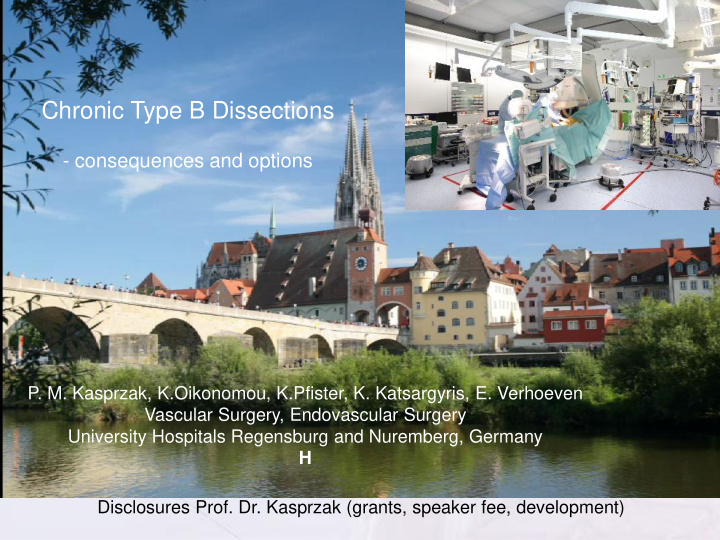



Chronic Type B Dissections - consequences and options P. M. Kasprzak, K.Oikonomou, K.Pfister, K. Katsargyris, E. Verhoeven Vascular Surgery, Endovascular Surgery University Hospitals Regensburg and Nuremberg, Germany H Disclosures Prof. Dr. Kasprzak (grants, speaker fee, development) Cook, Gore, Vascutek, Bard, Medtronic, Maquet, UCB, Bentley
Medical Therapy Alone is not Ideal • 30d Mortality: 10%, 3 year mortality: 25%! • 25% of survivors → Late complications – Dissection Extension – Chronic Pain – Aneurysm Formation (Rupture)
Follow-up after ATBAD • Prior to discharge – CTA & Ultrasound of visceral/renal vessels (CEUS) • 6 months – CTA & Ultrasound of visceral/renal vessels (CEUS) • Ultrasound after 6m and yearly with CTA
Treatment Indications of Chronic Dissection • Aneurysm • Rupture • (Malperfusion) • (Refractory Pain) • (Hypertension)
• TBAD - false lumen expansion requiring reintervention 30% Nienaber CA et al. Randomized comparison of strategies for type B aortic dissection: INSTEAD. Circulation 2009 • Complete false lumen thrombosis in 40% Kusagawa H. et al. Changes in false lumen after transluminal sten- graft placement in aortic dissections: six years experience. Circulation 2005 • False lumen (dissection) stable 30% • Post-TEVAR aneurysm in 35% Scali ST et al. Efficacy of TEVAR for cTBAD with aneurysmal degeneration JVS 2013
TEVAR ? • 527 Pt (17 Studies) • Technical Success 59.1-100% • 8% Ongoing Aneurysmal Dilatation
Endovascular Treatment Options
Dissection Type B with Aneurysm reno-mesenterial after TEVAR und EVAR
Technical Challenges • Thoracoabdominal Extend • Distal Landing Zone • Stiff Dissection Flap • Small true Lumen • Target Vessels from FL/TL
- DSA - IVUS - ECHO
Post-Dissection aneurysm Arteriosclerotis FEVAR / BEVAR Aneurysm-BEVAR staged procedures TEVAR + BEVAR TEVAR first 1. surgery with TASP fenestrated stentgraft TASP completion after 2. surgery not completed distally balloon branch occlusion Completion 3. surgery?
Endovascular Treatment Options - Iliacs
C After 18 mth’s h Preoperative Postoperative r o n i c P o s t d i s s. A n e u r y s m
Experience Regensburg/Nuremberg (N=71) (01/2008-04/2017) • 53/71 after previous surgery: – Open surgery for type A (N=15) – Open Surgery/TEVAR for type B (N=38)
Perioperative Results • Technical Success: N=68/71 (95.8%) 1 Conversion; 2 catheterization failures(LRA/SMA) • 30-day Mortality: N=4 (5.6%) • SCI Paraplegia N=2 (2.8%) Temporary Paraparesis Uni-/Bilateral N=9 (12.7%)
Freedom from Reintervention 80.7 ± 5.3% 1 Year 52.6 ± 8.0% 3 Years
Type Ib EL (LRA) LRA Stent-graft Extension
CT bridging stent in Dissection (after 2 years) Courtesy Prof. T. Jakimowicz, Warszawa (2 cases)
False Lumen Thrombosis 41/48 (85.4%) Patients that completed 1 year FU Post-op CT 2 years Mean Aneurysm Sac Regression 9.2 ± 8.8mm
Cumulative Survival 84.7 ± 4.5% 1 Year 70.0 ± 6.7% 3 Years
• 350 Pt • Early adverse outcome 15.9% (Exitus, NI, Stroke, Paraplegie)
Conclusions • False Lumen Thrombosis in TAA after ATBD is essential for aneurysm shrinkage and crucial for long term success • Rigorous FU is required: Aneurysm and Aneurysm related Mortality is increasing after 3-4 years • Open surgery indicated in Connective Tissue Disease • F/B grafts are a realistic option to treat post-dissection TAAA and is associated with a high Rate of False Lumen Thrombosis
Recommend
More recommend